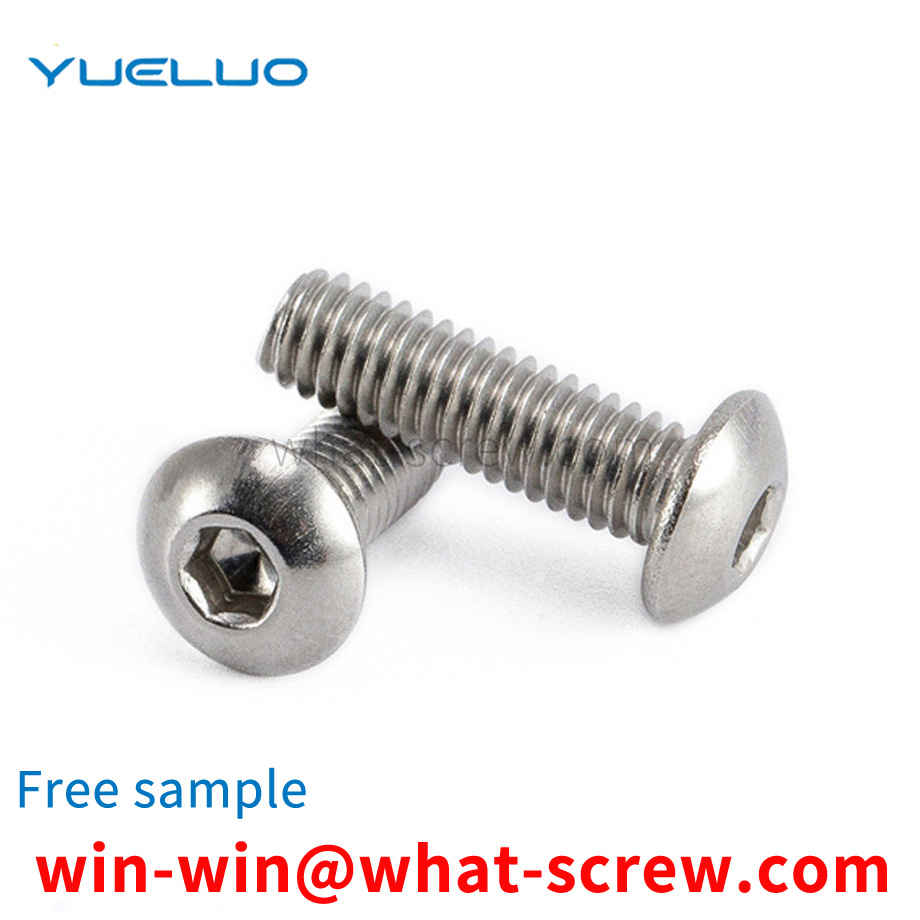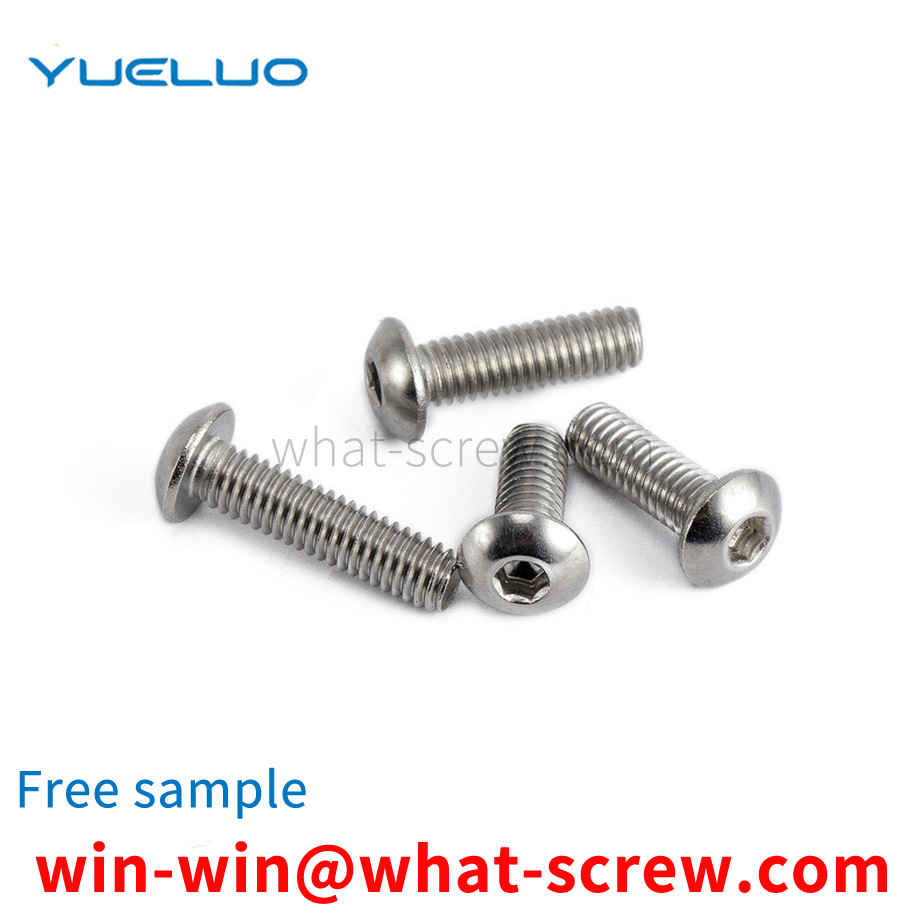Bolt: A type of fastener consisting of a head and a screw (a cylinder with an external thread), which needs to be matched with a nut to fasten and connect two parts with through holes. This form of connection is called a bolted connection. If the nut is unscrewed from the bolt, the two parts can be separated, so the bolt connection is a detachable connection. [1] Stud: A type of fastener that has no head and only has external threads on both ends. When connecting, one end of it must be screwed into the part with the internal threaded hole, the other end must pass through the part with the through hole, and then the nut must be screwed on, even if the two parts are tightly connected as a whole. This form of connection is called a stud connection, which is also a detachable connection. It is mainly used for occasions where one of the connected parts is thick, requires a compact structure, or is not suitable for bolt connection due to frequent disassembly. [1] Screw: It is also a type of fastener consisting of a head and a screw. It can be divided into three categories according to the purpose: machine screws, set screws and special-purpose screws. Machine screws are mainly used for a fastened connection between a part with a fixed threaded hole and a part with a through hole, without the need for nut matching (this connection form is called screw connection, which is also a detachable connection; it can also be Cooperate with the nut, it is used for the fast connection between two parts with through holes.) The set screw is mainly used to fix the relative position between the two parts. Special purpose screws, such as eyebolts, are used for hoisting parts. [1] Nuts: with internal threaded holes, generally in the shape of a flat hexagonal column, but also in a flat square column or flat cylindrical shape, with bolts, studs or machine screws, used to fasten and connect two parts, make it a whole. [1] 5. Self-tapping screw: Similar to machine screw, but the thread on the screw is a special thread for self-tapping screw. It is used to fasten and connect two thin metal components to make them a whole. Small holes need to be made in advance on the components. Due to the high hardness of this kind of screw, it can be directly screwed into the hole of the component, so that the Forming a corresponding internal thread [1] 6. Wood screw: It is also similar to a machine screw, but the thread on the screw is a special thread for wood screws, which can be directly screwed into wooden components (or parts) to connect a band through The metal (or non-metallic) part of the hole is fastened to a wooden member. This connection is also a detachable connection. [1] 7. Washers: A type of fastener with an oblate annular shape. It is placed between the supporting surface of the bolt, screw or nut and the surface of the connecting part, which increases the contact surface area of the connected parts, reduces the pressure per unit area and protects the surface of the connected parts from damage; another type of elastic washer, It can also play a role in preventing the nut from loosening. [1] 8. Retaining ring: It is installed in the shaft groove or shaft hole groove of the machine and equipment, and plays the role of preventing the parts on the shaft or the hole from moving left and right. [1] 9. Pins: mainly used for positioning the left and right parts, and some are also used for connecting parts, fixing parts, transmitting power or locking fasteners. [1] 10. Rivet: A type of fastener consisting of a head and a shank, which is used to fasten and connect two parts (or components) with holes to make them a whole. This form of connection is called rivet connection, or riveting for short. It is a non-removable link. Because if the two parts joined together are separated, the rivets on the parts must be broken. [1] 11. Components and connection pairs: Assemblies are a type of fasteners supplied in combination, such as a combination of a certain machine screw (or bolt, self-supplied screw) and a flat washer (or spring washer, lock washer); Connection pair refers to a type of fastener that is supplied by a combination of special bolts, nuts and washers, such as high-strength hexagon head bolt connection pairs for steel structures. [1] 12. Welding nail: a heterogeneous fastener composed of a nail rod and a nail head (or no nail head), which is fixed to a part (or component) by welding, so as to be connected with other parts. .
At present, the locking washer is widely used in the upper wheel side locking of passenger cars. During assembly, the locking washer is bent perpendicular to the thread of the axle pipe, so as to prevent the protrusion from passing through the gap between the two tooth profiles of the thread and ensure the locking The stop gasket is always in the groove of the shaft tube and cannot be rotated to achieve the purpose of locking. This method is relatively simple and is currently used more;
A T-shaped grounding bolt comprises a connection platform, a hexagonal bolt is welded below the described connection platform, and the lower surface edge of the described connection platform is provided with a barb.
The working principle of the nut is to use the friction between the nut and the bolt for self-locking. However, the reliability of this self-locking is reduced under dynamic loads. In some important occasions, we will take some anti-loosening measures to ensure the reliability of the nut locking. Among them, the use of lock nuts is one of the anti-loosening measures. There are also two types of locking nuts. One is to use two identical nuts to screw on the same bolt, and a tightening torque is added between the two nuts to make the bolt connection reliable. The other is a special lock nut, which needs to be used together with a lock washer. As shown in FIG. 1, a plastic gasket 2 is arranged in the center of the nut 1 to play a locking effect, but the process is complicated and the production is inconvenient. One is to drill through threaded holes from the outer surface of the nut to the inner thread surface (usually 2, distributed at 90 on the outer surface), which are used to screw in small-diameter countersunk head screws. The purpose is to apply a thread to the thread. A centripetal force prevents the lock nut from loosening. At present, the lock nut with better quality on the market is inlaid with small copper pieces that are consistent with the thread of the lock nut on the inner surface of the nut, which is used to prevent the radial jacking screw from directly contacting the locked thread and being damaged. By. This kind of lock nut is gradually applied in the shaft end locking of rotating motion parts, such as the anti-looseness of the bearing at the mounting end of the ball screw. The process is equally complex.
Guangdong Yueluo Hardware Industry Co., Ltd. provides a screw positioning pin, which is composed of a main body part and an insert part. The main body part is a circular boss structure, and the bottom of the circular boss structure is provided with a rectangular groove. The inserting part is fixed on the middle part of the upper surface of the main body part, the lower part of the inserting part and the contact section of the main body part are in a circular truncated structure, the upper part of the inserting part is a cylindrical structure, and the outer surface of the cylindrical structure is provided with threads; the screw positioning pin , The structure is simple and the design is ingenious. The special structural design of the main part and the insert part can be positioned between the punch and the die in the first processing process, effectively reducing the gap formed during the processing between the punch and the die. Firmly fixed, suitable for the needs of large-scale industrial production.
We have many years of experience in the production and sales of screws, nuts, flat washers, etc. The main products are: DIN975 screws, Wasser 45 steel, 30 type 40 type, stud welding nuts and other products, we can provide you with suitable fasteners for you solution.



















 Service Hotline
Service Hotline




